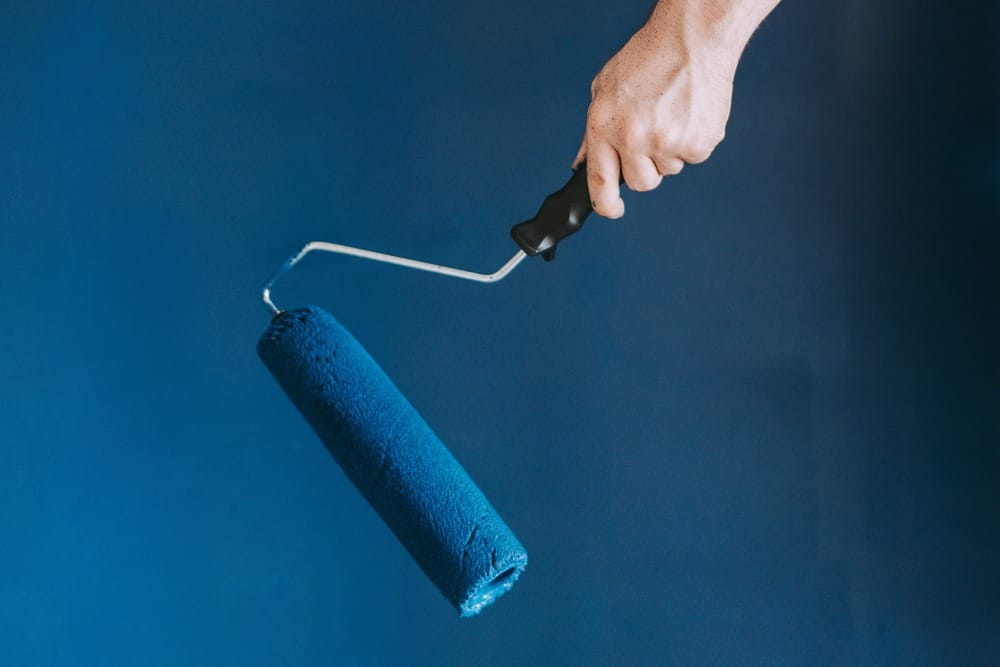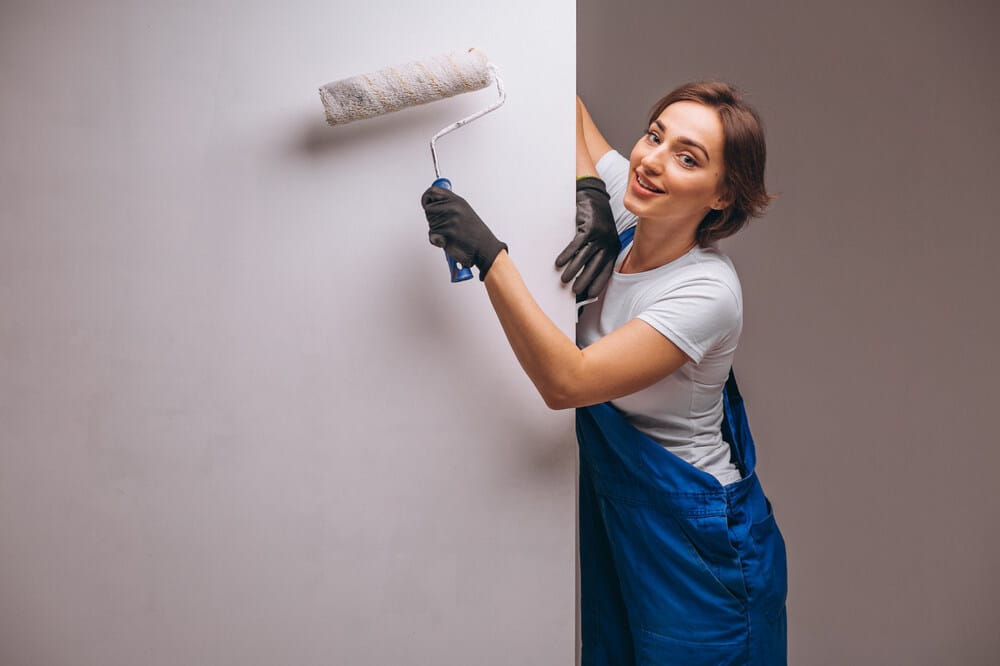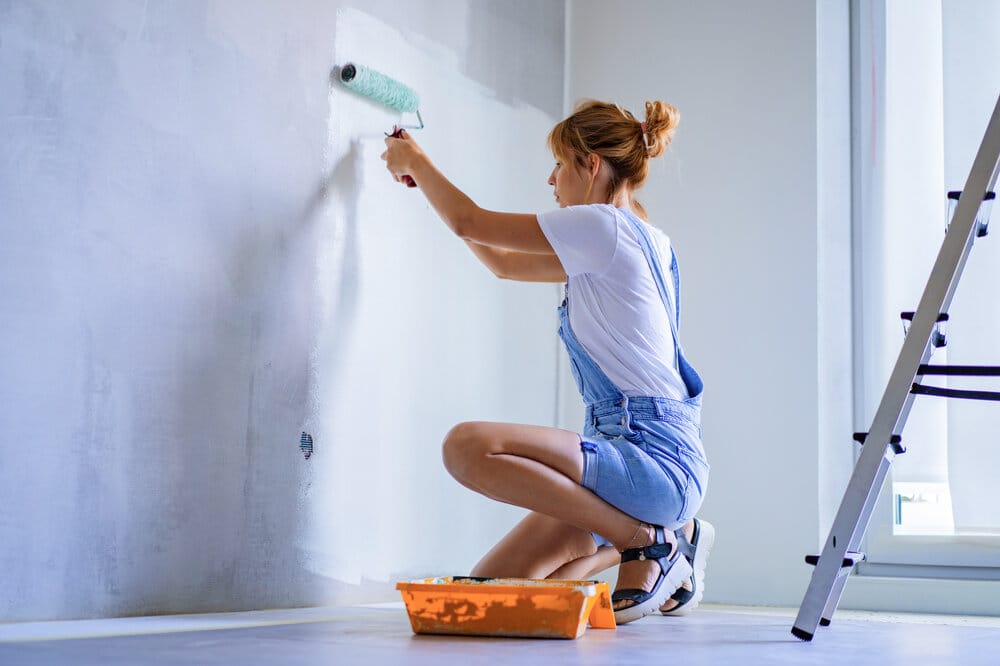Menu

Key Takeaways✔ Beige, taupe, and off-white create a timeless, versatile, and calming backdrop for any space. ✔ Earthy tones like terracotta and ochre add warmth and energy, making rooms feel cozier. ✔ Vibrant colors like emerald green and navy make a statement without overwhelming a space. ✔ Greens, blues, and browns bring a serene, biophilic feel to interiors. ✔ Soft hues like blush pink and powder blue offer a sophisticated yet subtle charm. ✔ Charcoal gray and deep navy create dramatic, cozy, and elegant spaces. ✔ This natural, chalky-textured finish adds depth and an organic aesthetic. ✔ Matte, metallic, and plaster finishes elevate walls with dimension and sophistication. ✔ Dividing walls with complementary colors adds visual interest and depth. ✔ Bold colors, patterns, or metallic finishes transform ceilings into stylish focal points. ✔ Low-VOC and non-toxic options provide healthier, sustainable choices for homes. ✔ A timeless, high-contrast look that balances depth and brightness. ✔ Gold, silver, and pearlescent hues add a luxurious and modern touch. ✔ Blended color transitions create movement and artistic expression. ✔ Enveloping walls, ceilings, and trim in one bold hue make a dramatic statement. |
Interior painting in 2025 brings a blend of bold creativity, timeless elegance, and modern innovation. From vibrant accent walls to eco-friendly paints and textured finishes, these trends redefine residential spaces with style and personalization. They reflect a desire for unique, welcoming environments that balance aesthetics with functionality.
Here are the top 15 ideas shaping modern homes this 2025.

Neutral color palettes have become a cornerstone of modern interior design due to their timeless charm and versatility. These hues, including beige, taupe, and off-white, provide a clean and sophisticated backdrop for any space. Neutrals are especially valued for their ability to harmonize with a variety of decor styles, whether minimalist, industrial, or Scandinavian. They create a calming atmosphere, making them ideal for living rooms, bedrooms, and open-plan areas.
A neutral palette allows homeowners to experiment with textures and accents without the risk of overwhelming the space. The subtlety of these colors provides an elegant canvas for artwork, furniture, and accessories. For instance, pairing taupe walls with natural wood furniture or metallic accents can add depth and character to a room. Interior house painting professionals often recommend neutrals for small spaces, as their light-reflective qualities make rooms feel larger and more open.
Warm and earthy tones such as terracotta, ochre, and cinnamon are redefining comfort in interior house painting. These colors evoke feelings of warmth and intimacy, making them ideal for spaces where family and friends gather, such as living rooms, kitchens, and dining areas. Warm shades not only create a cozy atmosphere but also bring a sense of energy and positivity to the home.
In modern design, these tones are often paired with complementary materials like natural wood, rattan, or stone. For instance, a terracotta accent wall can be paired with neutral furnishings and greenery to create a balanced, earthy aesthetic. Residential painting services often recommend these shades to homeowners seeking a welcoming and grounded environment.
Bold accent walls are a striking way to add personality and focus to a room. Vibrant hues like emerald green, deep navy, and mustard yellow are commonly chosen for their dramatic impact. These colors are often used to highlight architectural features, such as a fireplace, built-in shelving, or a large piece of artwork. An accent wall creates a focal point that draws the eye, adding visual depth and dimension to a space.
This trend allows homeowners to experiment with bold colors without overwhelming the entire room. By limiting the vibrant hue to one wall, the remaining walls can remain neutral, providing balance and cohesion. Professional residential painting services frequently use this technique to help clients achieve a statement look while maintaining overall harmony.
Nature-inspired hues are increasingly popular in interior house painting as homeowners seek to bring the outdoors inside. Greens, blues, and earthy browns create a serene and grounding environment that fosters relaxation and connection to nature. These colors align with the principles of biophilic design, which emphasizes harmony with the natural world.
Shades like moss green and sky blue are perfect for spaces where calmness is desired, such as bedrooms, bathrooms, and home offices. Meanwhile, earthy browns can add warmth and stability to living areas. Residential painting services often suggest these hues to homeowners looking for a timeless and tranquil aesthetic.
Muted pastels are a sophisticated choice for modern interiors, offering a blend of subtlety and charm. Colors like powder blue, blush pink, and pale yellow are versatile and timeless, making them suitable for both contemporary and vintage-inspired designs. These shades add a touch of softness to a space, creating a welcoming and serene atmosphere.
Muted pastels are especially effective in spaces where natural light is abundant, as they reflect and amplify brightness without overwhelming the room. They pair well with white trims and neutral furnishings, creating a fresh and airy aesthetic. Interior house painting professionals often recommend these hues for bedrooms, nurseries, and bathrooms due to their calming effect.
Dark and moody tones like charcoal gray, deep navy, and plum are increasingly favored for creating dramatic and sophisticated interiors. These rich hues can transform a space into a cozy retreat or an elegant statement area. Perfect for dining rooms, home libraries, or even accent walls in living spaces, these colors exude confidence and style.
One of the primary appeals of dark tones is their ability to add depth and intimacy to a room. When paired with proper lighting, such as pendant lights or wall sconces, these shades can create a warm and inviting ambiance. Residential painting services often recommend dark colors for homeowners who wish to add a sense of luxury or a bold aesthetic to their spaces.

Limewash is making a strong comeback in 2025 as a must-try painting technique for interiors. This age-old finish, known for its soft, chalky texture and natural aesthetic, creates an understated yet elegant look. Limewash paint is made with natural limestone, offering a subtle variation in tone that adds depth and character to walls.
Textured paints are making a strong impact in interior house painting, offering homeowners a way to add depth and dimension to their walls. From matte to metallic finishes, textured paints can elevate a simple wall into a feature that exudes luxury and sophistication. Faux plaster finishes, in particular, are gaining traction for their artisanal and rustic appeal.
These finishes work exceptionally well in spaces like living rooms, dining areas, and bedrooms, where the texture can serve as a subtle yet striking backdrop. Residential painting services often recommend textured paints for those looking to move beyond traditional flat walls and add a touch of uniqueness to their homes.
Two-tone walls are a stylish way to introduce visual interest and dimension to a room. By dividing a wall into two distinct sections with complementary colors, homeowners can create a striking design that feels both modern and intentional. Horizontal divisions often make ceilings appear higher, while vertical splits can add a sense of structure and height.
This trend is highly customizable, allowing homeowners to experiment with bold and neutral tones or even contrasting finishes like matte and glossy. Residential painting services frequently recommend two-tone walls for spaces like dining rooms, bedrooms, or home offices, where they can enhance the room’s proportions and add depth.
Ceiling accents are gaining attention as homeowners look beyond walls to add character and style to their interiors. Whether it’s a bold color, a pattern, or even a textured finish, painted ceilings can redefine a room’s aesthetic and proportions.
This trend works particularly well in rooms with high ceilings, where bold colors can make the space feel cozier. Conversely, lighter shades on the ceiling can create the illusion of more height in smaller rooms. Residential painting services often suggest ceiling accents as a way to tie a room’s design together and make a unique statement.
Eco-friendly paints, also known as non-toxic or natural paints, are becoming a top choice in residential painting services as sustainability takes center stage in home improvement. Made with safe, natural ingredients, these paints are low-VOC (volatile organic compounds) or zero-VOC, reducing indoor air pollution and ensuring a healthier environment for families.
Interior house painting professionals frequently recommend these options for clients who prioritize eco-conscious living.
The timeless elegance of black and white contrast makes it a perennial favorite in modern interior design. This classic combination works well in various styles, from minimalist to industrial, offering both simplicity and boldness. Black adds depth and drama, while white provides brightness and openness, creating a balanced and striking look.
This color scheme is particularly effective in spaces where sharp lines and geometric patterns are prominent. For instance, a black accent wall paired with white furnishings can make a powerful design statement. Residential painting services often recommend black-and-white schemes for homeowners seeking a sophisticated and modern aesthetic.
Metallic and iridescent finishes are among the most luxurious trends in interior house painting, bringing a sense of elegance and modernity to any room. These finishes reflect light beautifully, adding depth and a touch of glamour. Available in shades like gold, silver, bronze, and even pearlescent hues, metallic paints are perfect for accent walls, ceilings, or even furniture.
These finishes are particularly effective in spaces like dining rooms, bedrooms, or entryways, where they can create a striking focal point. Residential painting services often recommend metallic paints for clients seeking a luxurious or futuristic aesthetic. When paired with neutral tones or darker colors, metallic finishes can elevate the overall design of a space.
Gradient and ombre walls are among the most artistic and eye-catching trends in residential painting services. This technique involves blending two or more colors seamlessly, creating a gradual transition from one hue to another. The result is a visually stunning effect that adds movement and depth to any space.
These walls are particularly popular in creative spaces like bedrooms, living rooms, or dining areas, where they serve as a focal point. Gradient walls can range from subtle transitions between pastel tones to bold combinations of vibrant colors. Interior house painting professionals often use this technique to create unique and personalized designs for their clients.
Color-drenching is one of the boldest interior painting trends for 2025, offering a dramatic yet cohesive aesthetic. This technique involves using a single color across walls, ceilings, and even trim to envelop the room in a unified hue. The effect creates an immersive and striking look, making a powerful design statement while maintaining harmony.
Avoid heavy cleaning for the first few weeks to allow the paint to fully cure. Dust the walls regularly using a soft cloth or vacuum with a brush attachment. For stains, use a mild detergent and warm water with a soft sponge, avoiding abrasive cleaners. Touch up small scratches or marks promptly to maintain a pristine look.
Painting a room yourself is cost-effective and rewarding if you have the time and patience. With proper tools and preparation, DIY projects can achieve excellent results. However, professionals bring expertise, speed, and high-quality finishes, especially for large or complex spaces. Consider hiring help for areas with high ceilings, intricate designs, or tight timelines.
The best time to paint the interior is during mild weather, typically in spring or fall when humidity is lower. Lower humidity allows paint to dry faster and reduces the risk of streaking or improper adhesion. However, indoor painting can be done year-round if the space is well-ventilated. Avoid painting during very humid or rainy periods, as moisture can affect drying times.
Start by considering the room’s purpose, lighting, and existing décor. Neutral shades are versatile and timeless, while bold colors can create dramatic or cozy effects. Test paint samples on walls and observe how the colors look under different lighting conditions throughout the day. Online color visualization tools can also help you imagine how a room will appear with new shades. Always choose a color that complements the room’s furniture and overall design theme.
Preparing a room involves cleaning the walls to remove dirt, grease, or dust and ensuring the surface is smooth. Fill in any cracks or holes with spackle, then sand the patched areas for a seamless finish. Cover furniture and flooring with drop cloths or plastic sheeting to protect them from paint splatters. Remove light switch covers, outlet plates, and any wall décor before starting.
Ready to refresh your home with professional painting? West Hartford House Painting Experts are here to deliver exceptional results tailored to your style. Whether you need precise interior house painting, expert wall painting tips, or eco-friendly solutions, we’ve got you covered. Serving the West Hartford, CT community, West Hartford House Painting Experts specializes in creating beautiful, personalized spaces with a flawless finish.
Contact West Hartford House Painting Experts today and let us transform your home in West Hartford, CT, with unparalleled craftsmanship and care!

Welcome to West Hartford House Painting Experts. We believe that we are the highest quality painting company in this community and we provide excellent customer service!